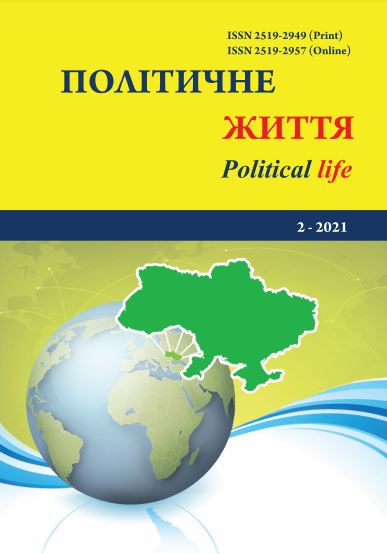Digitalization of Public Diplomacy of the United States During the Presidency of Donald Trump
DOI:
https://doi.org/10.31558/2519-2949.2021.2.19Keywords:
digitalization; public diplomacy; USA; D.TrumpAbstract
Digitalization is one of the most essential components of modern globalization process.
Today, especially during the COVID-19 pandemic, there are almost no areas left that are not being affected by modern information technologies. Digitalization has become the basis of transformational processes of the world economy, cultural development, political life, etc. The sphere of foreign policy activity is not an exception, using digital technologies in its work. The usage of modern digital technologies has led to the abrupt changes in the diplomatic sphere, changing the form of its work. The key players of the international relations system actively use resources of the information and communication technologies in their diplomatic work.
The United States of America has become a pioneer in the application of the digital technologies into diplomacy. There are institutions at the state level that implement modern digital technologies into the country’s foreign policy activities in order to achieve strategic interests and ensure the national security. The article analyzes trends in digitalization of the Public Diplomacy in the United States of America under the Trump administration. The main mechanisms and platforms for using modern information and communication technologies are described. It is proved that under the presidency of Trump’s digitalization of US public diplomacy has been taking place at a significant pace. The main directions of application of modern digital technologies in the field of US public diplomacy are traced. The role of the so-called «New Media» in the foreign policy activities of the Trump administration is studied. The paper proves that Donald Tramp had a peculiar way of communication using the social network Twitter, which often contradicted the activities of other high-ranking US officials and, in some places, did not coincide with the declared the foreign policy course of the state.
References
Cull N. The long road to public diplomacy 2.0: The internet in US public diplomacy. International Studies Review, 2013. 15(1). URL https://ash.harvard.edu/files/cull.pdf.
Donald Trump and Twitter – 2009/2021 analysis. URL https://www.tweetbinder.com/blog/trump-twitter.
Guo L, Vargo CJ. Global intermedia agenda setting: A big data analysis of international news flows.
Journal of Communication, URL https://chrisjvargo.com/wp-content/uploads/2017/09/1finalvargoguojoc.pdf.
Hanson F. Baked in and wired: eDiplomacy@State. Foreign Policy Paper Series, 2012 N. 30. URL https://www.brookings.edu/wp-content/uploads/2016/06/baked-in-hansonf-5.pdf.
Holland J., Fermorю B. Trump’s rhetoric at 100 days: Contradictions within effective emotional narratives. Critical Studies on Security, 2017. № 5(2). Р. 182–186.
Lewis D. Digital diplomacy. URL https://www.gatewayhouse.in/digital-diplomacy-2.
Manor I., Segev E. America’s Selfie: How the US Portrays Itself on its Social Media Accounts. URL https://www.researchgate.net/profile/Ilan-Manor/publication/274072913_America%27s_Selfie_How_the_US_ Portrays_Itself_on_its_Social_Media_Accounts/links/592c2a880f7e9b9979adb46c/Americas-Selfie-How-the-US-Portrays-Itself-on-its-Social-Media-Accounts.pdf.
«Most Worthless» US Government Agency May Become Trump TV. URL https://observer.com/2018/08/ broadcasting-board-of-governors-us-agency-for-global-media-michael-pack-trump
Nakamura K. U.S. public diplomacy: Background and current issues. URL https://www.everycrsreport.com/ files/ 20091218_RL40989_8bcc8e70bd9054330fff89f1a844d65c412f35ef.pdf.
Panke D., Petersohn U. President Donald J. Trump: An agent of norm death? International Journal: Canada’s Journal of Global Policy Analysis, 2017. 72 (4). P. 572 – 579.
Potter E., Cyber-Diplomacy: Managing Foreign Policy in the Twenty-First Century. URL https://books.google.com.ua/books?hl=en&lr=&id=aV6hwJEtZuUC&oi=fnd&pg=PR11&ots=ZZdzEPe48F&sig=3cOdgkmgxHvOZzOWbMEFiLkWiuc&redir_esc=y#v=onepage&q&f=false
Šimunjak M., Caliandro A. Twiplomacy in the age of Donald Trump: Is the diplomatic code changing? The Information Society, 2019. № 35(1). Р. 13–25.
2016 Comprehensive Annual Report on Public Diplomacy and International Broadcasting.
URL https://2009-2017.state.gov/documents/organization/262381.pdf
2017 Comprehensive Annual Report on Public Diplomacy and International Broadcasting. URL https://www.state.gov/wp-content/uploads/2019/05/2017-ACPD.pdf
2018 Comprehensive Annual Report on Public Diplomacy and International Broadcasting. URL https://www.state.gov/wp-content/uploads/2019/05/2018-ACPD.pdf
2019 Comprehensive Annual Report on Public Diplomacy and International Broadcasting: Focus on FY 2018. URL https://www.state.gov/wp-content/uploads/2020/01/2019-ACPD-Annual-Report.pdf
2020 Comprehensive Comprehensive Annual Report Annual Repor t on Public Diplomac Diplomacy & International Broadcastin International. URL https://www.alliance-exchange.org/wp-content/uploads/2021/02/ACPD_2020Report_FINAL_DIGITAL_508.pdf
2020) GEC Special Report: August 2020 Pillars of Russia’s Disinformation and Propaganda Ecosystem. URL https://www.state.gov/wp-content/uploads/2020/08/Pillars-of-Russia%E2%80%99s-Disinformation-and-Propaganda-Ecosystem_08-04-20.pdf.
U.S. Department Of State. URL https://www.state.gov/about-us-office-of-global-social-media/
U.S. Public Diplomacy: Background and Current Issues. URL https://fas.org/sgp/crs/row/R40989.pdf.
White House: Trump’s tweets are official statements. CNN Politics, 2017. URL: https://edition.cnn.com/2017/06/06/politics/trump-tweets-official-statements/index.html.
Zhong X, Lu J. Public diplomacy meets social media: A study of the U.S. embassy’s blogs and micro-blogs. Public Relations Review, 2013. https://daneshyari.com/article/preview/10255962.pdf.

